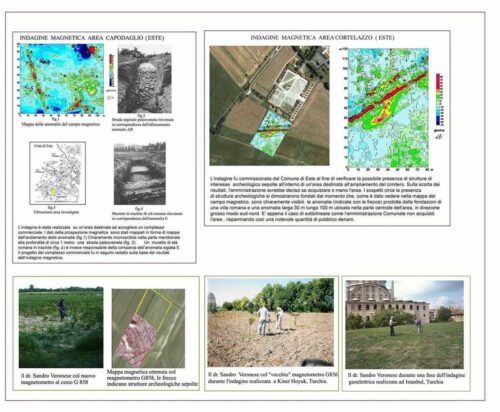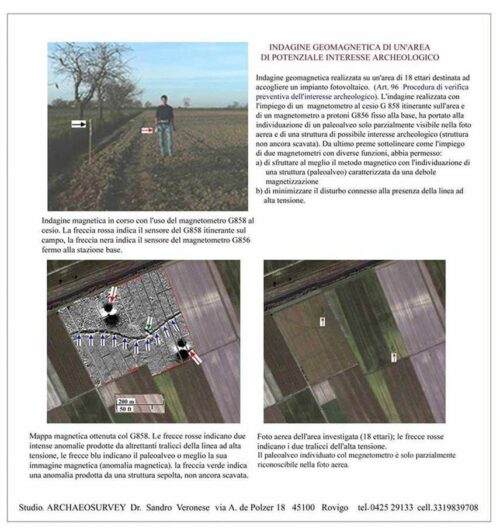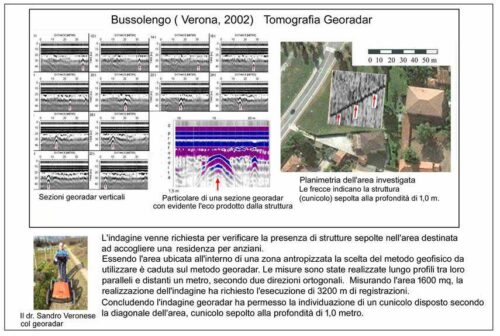Come evitare il rischio della sospensione dei lavori quando si opera con scavi all’interno o in prossimità di aree di interesse archeologico
Succede a volte che strutture archeologiche vengano alla luce durante i lavori per lo scavo di un canale, la costruzione di una strada , di una metropolitana, di un garage sotterraneo, di un’area commerciale, ecc… insomma laddove vengono realizzati scavi più o meno profondi. La Soprintendenza archeologica interviene imponendo il fermo dei lavori con conseguenze riassumibili in perdita di tempo e in un aggravio dei costi e l’impresa deve accollarsi le spese dello scavo archeologico.
Come evitare tutto questo ? Risposta, utilizzando le metodiche geofisiche non invasive (non richiedono l’apertura di trincee e l’esecuzione di sondaggi) che permettono di vedere senza scavare l’eventuale presenza di strutture archeologiche sepolte. Riassumendo : è possibile appurare la presenza di reperti in terreni in tempi brevissimi e con costi estremamente contenuti . Da ultimo si precisa che l’utilizzo delle metodiche geofisiche è previsto dal Decreto Legislativo 163/2006 (Codice dei contratti pubblici relativi a lavori, servizi e forniture) ovvero le norme sull’archeologia preventiva (artt. 95 e 96). (obbligo di verifica dell’interesse archeologico)
Lo Scrivente Dr. Sandro Veronese realizza da oltre 35 anni indagini geofisiche non invasive nel campo archeologico utilizzando i metodi più moderni ed efficaci (metodo magnetico, metodo georadar metodo geoelettrico ), metodi geofisici non invasivi con i quali è possibile rilevare la presenza nel sottosuolo di strutture quali: fondazioni, pavimenti, strade, forni, focolari, tombe, sepolture, pozzi, cavità, latrine, fossati, buche di pali e molte altre ancora. Numerosi esempi di indagini geofisiche sono riportati nel sito : www.geo-land.it
Qui sotto sono riportati i risultati di quattro indagini geofisiche particolarmente significative realizzate dallo Scrivente, tre sono state realizzate col metodo geomagnetico, una col georadar.
Le prime due sono state realizzate nel Comune di Este (Padova). Le indagini furono commissionate al fine di verificare la presenza di strutture archeologiche nel sottosuolo di due aree destinate una ad accogliere un complesso commerciale (Area Capodaglio), l’altra all’ampliamento del Cimitero (Area Cortelazzo). La terza indagine realizzata nel Comune di Aquileia (Udine), ha interessato una area di 18 ettari, area destinata ad accogliere un impianto fotovoltaico. L’indagine geomagnetica eseguita in sole due settimane (grazie all’uso combinato del magnetometro al cesio e del magnetometro a protoni) ha invece rivelato che il sottosuolo dell’area non nascondeva al suo interno strutture di interesse archeologico. L’area considerata di interesse archeologico è diventata utilizzabile senza nessuna restrizione d’uso. Il metodo della prospezione georadar è stato utilizzato in un’area del Comune di Bussolengo (Verona), per verificare la presenza di strutture archeologiche in un’ area destinata ad accogliere una residenza per anziani. (per inciso nell’area è stato individuato un cunicolo alla profondità di 1 mt)
Distinti saluti Rovigo 07/12/2016
Dr. Sandro Veronese
Studio Geofisica via de Polzer 18 45100 Rovigo tel. 0425 29133 cell. 3319839708
Sito web : www.geo-land.it
Alcune opinioni circa l’attività del dr. Sandro Veronese espresse da geofisici europei e statunitensi
Dear Dr. Veronese,
I was very impressed by the results you present on your Web site and
have taken the liberty to include it on our link page
( http://www.brad.ac.uk/acad/archsci/subject/archpros.htm ).
Thank you very much for this information,
Yours sincerely
Prof. Armin Schmidt University of Bradford U.K
Dear Dr. Veronese,
Thank you for your e-mail. I have found some your examples on the web site
and in my mind they are realy interesting and impressional. I with my
colleagues have made some anological investigation of archeological objects
using electric tomography and magnetometer, but our results were not so good
as your.
yours sincerely,
Rimantas ( Geological Survey of Lithuania)
Dear Sir,
Fantastic magnetic data at Lupia! I was curious as to the specifications of the survey, grid size, resolution (data point spacing). Seems like it is very High Resolution data.
I work for a geophysical consulting company in the US and we seem to specialize in High Resolution.
We have recently used a prototype combination G-858 Cesium vapor gradiometer and GPS system to collect over 100,000 data points for use un paleochannel delineation.
The idea of building a 3-D surface map similar to yours was foremost on my mind. Unfortunately the large scale prohibited such presentation.
Nevertheless, I was very intrigued by your site and presentation of the magnetics data. Sincerely,
Marc T. Levitt Geological Engineer
hydroGEOPHYSICS, Inc. Tel. (520) 647-3315 b Fax. (520) 647-3428
Dear Dr. Veronese:
Thank you for your interest in our research program at Boston University.
I am impressed with the quality of work your institution has undertaken and
was aware of your work prior to your email. Thus, I am delighted to hear
of your interest in pursuing a collaborative relationship in the future
Sincerely,
Patrick Ryan Williams, Ph. D., RPA Assistant Professor Department of Archaeology
Boston University
675 Commonwealth Ave #347 Boston, MA 02215 (617) 358-1645 fax 353-6800
prwill@bu.edu
Have reviewed your packet. I am VERY impressed with the Mag maps and the
resistivity. Great work. ……
Larry Conyers
Department of Anthropology University of Denver 132 Sturm Hall Denver, CO 80208
Thank you for your message. Each year we hold an international archaeometry conference at Buffalo.
Usually it occurs in Feb when the snow is high and the countryside is very beautiful.
Perhaps you would be interested in attending and presenting a paper on some of your more recent work.
Ezra Zubrow Professor, Anthropology Director, Archaeometry Laboratory
Dear Sandro,
I thank you very much for your email message. Yes I would like to
maintain a professional relationship with you. Thank you for your interest
in geophysical resesarch. I wish you the best of professional success !!!
Payson
Payson Sheets University of Colorado at Boulder
Dear Dr. Veronese,
It is with great interest that I have just received your e-mail message,
and looked at your web-site, since I have been looking for a specialist to carry out a geophysical survey at Kinet Hoyuk.
Sincerely yours,
Marie-Henriette Gates
Bilkent University Department of Archaeology and History of Art 06533 Bilkent.
Ankara (Turkey)Director, Kinet Hoyuk Excavations
Dear Sandro,
Thank you very much for the interesting information.
I hope you are planning to attend the EEGS meeting in Budapest.
If so, let’s meet there to have a more detailed discussion. I’m looking forward to seeing you soon.
Best regards,
Mark Goldman. ( Inst. For Petroleum Research and Geophysics) Israel
Dear Dr. Veronese,
Many thanks for your message. I find the result of your work very impressive
and I am glad to hear that you would like to work for us. ……..……
Best wishes,
Adolf Fridriksson
Institute of Archaeology, Iceland
Dear Dr. Veronese
This and your other two e-mails are very interesting. I have passed them on to a Mike Dolamore
who is responsible for the archaeological aspects of research work by the Durand Group which
is engaged in investigation of historical military subterranean features.
I have also passed them on to Peter Sawyer of the Heritage Conservation Programme,
Public Works and Government Services Canada. He is presently considering
Geophysical methods for investigating subsurface features under Canadian Battlefield Memorial Sites.
sincere regards and thanks
Phillip Robinson (Chairman Durand Group)



